Our exhaustive coverage of the ISC19 Student Cluster Competition continues as we discuss the application scores below. While the scores were typically high, some of the apps, like SWIFT and OpenFOAM, really pushed the students to the edge, judging by the average and median scores.
Here are the final results for the HPC application portion of the competition:
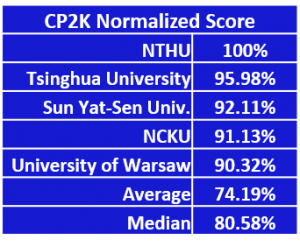 CP2K: This is a quantum chemistry and solid state physics application that can perform atomistic simulations of solids, liquid, molecular, periodic, material, crystal, and biological systems. You want to use Gaussian or plane wave approaches? Go for it. CP2K is like a Swiss Army knife of figuring out the physics behind materials and stuff.
CP2K: This is a quantum chemistry and solid state physics application that can perform atomistic simulations of solids, liquid, molecular, periodic, material, crystal, and biological systems. You want to use Gaussian or plane wave approaches? Go for it. CP2K is like a Swiss Army knife of figuring out the physics behind materials and stuff.
Taiwan’s NTHU nailed the top score, with Tsinghua only four points behind. Sun Yat-Sen took third with a score of 92.11%. National Cheng Kung University from Taiwan came out of no where to take the fourth place slot with Warsaw right behind them to take fifth – great job!
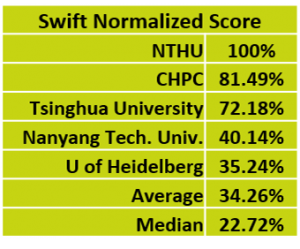 SWIFT: You wake up one morning and realize that you’d like to do some modeling on how gravity and hydrodynamics affect materials. A good example is if you want to see what happens when you drop a cow from a helicopter into a lake. What do you do? You get SWIFT.
SWIFT: You wake up one morning and realize that you’d like to do some modeling on how gravity and hydrodynamics affect materials. A good example is if you want to see what happens when you drop a cow from a helicopter into a lake. What do you do? You get SWIFT.
While our students weren’t modeling a cow & helicopter scenario, they did have to run SWIFT on their clusters and run SWIFT they did.
NTHU topped the field with their 100% normalized score, showing that they were the swiftest to solution on this app. CHPC was eating NTHU’s dust with their score of 81.49% and Tsinghua was even farther behind with their 72.18% mark. However, this was a difficult application for all of the teams, as shown by the low 22.72% median score.
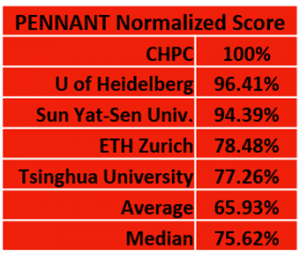 Mystery Application: The Mystery Application for the ISC19 Student Cluster Competition was the PENNANT application from Los Alamos National Lab. It’s an app that helps find more efficient implementations of unstructured mesh physics on different architectures (like GPUs, for example).
Mystery Application: The Mystery Application for the ISC19 Student Cluster Competition was the PENNANT application from Los Alamos National Lab. It’s an app that helps find more efficient implementations of unstructured mesh physics on different architectures (like GPUs, for example).
CHPC took the flag on PENNANT (I hate puns, but will stoop to them when I can’t think of anything else) narrowly finishing ahead of Heidelberg, who was less than four points behind. However, Heidelberg barely held off Sun Yat-Sen, who was only two points behind. ETH Zurich and Tsinghua put forth the effort , but the PENNANT gods did not smile upon them. Most of the other teams had a reasonably good time with PENNANT, judging by the median score of 75.62% and average score of nearly 66%.
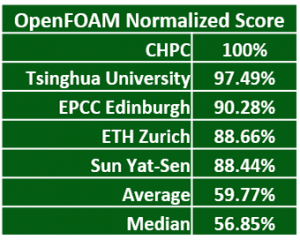 OpenFOAM is a free open source computational fluid dynamics package that does about anything you’d want to do. Need to work with incompressible flows? Incomprehensible flows? Compressible flows? Or even analyze foam? OpenFOAM is your answer. Same thing for conjugate heat transfers and combustion problems. Hell, it even has Direct Simulation Monte Carlo solvers. What more could you ask for?
OpenFOAM is a free open source computational fluid dynamics package that does about anything you’d want to do. Need to work with incompressible flows? Incomprehensible flows? Compressible flows? Or even analyze foam? OpenFOAM is your answer. Same thing for conjugate heat transfers and combustion problems. Hell, it even has Direct Simulation Monte Carlo solvers. What more could you ask for?
Our student teams felt that OpenFOAM was a pretty difficult piece of code to optimize. There are a lot of levers, toggles, and knobs in the software. The plucky South African team from CHPC set a blistering pace with their 100% normalized score on OpenFOAM, but the kids from Team Tsinghua weren’t fare behind at 97.49%. EPCC Edinburgh gets into the top three with a 90% score, while the pride of Switzerland, ETH Zurich, and China’s Sun Yat-Sen crossed the line with nearly identical scores.
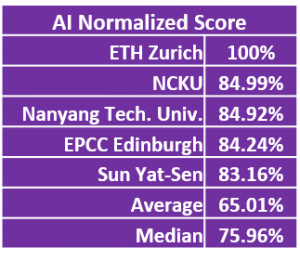 AI Application: The AI application this year deals with extremes in weather and has students using TensorFlow and Horovod to train models that are highly accurate when inferencing through the provided datasets.
AI Application: The AI application this year deals with extremes in weather and has students using TensorFlow and Horovod to train models that are highly accurate when inferencing through the provided datasets.
ETH Zurich’s AI model produced the highest accuracy and earned them 100% on this exercise. Taiwan’s National Chung Keng University grabbed a surprise second place finish with their economical dual-workstation cluster, showing they can beat the big clusterers when it comes to an application that doesn’t demand a lot of raw power.
Nanyang Tech took home third place, sandwiched in between NCKU in second and EPCC Edinburgh in fourth. Sun Yat-Sen nailed down a honorable mention, finishing just behind the leaders.
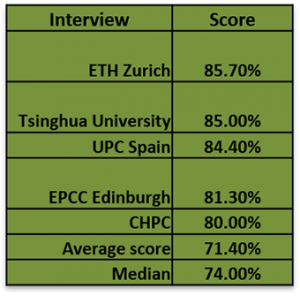 Interview: The final scored portion of the competition is the interview. This is where HPC experts visit each team and ask piercing questions like “what make you decide on this particular configuration?” and “how did you optimize _____ application?” or “what was your speed up on _______ as compared to your original run?” Teams are really put on the spot as they try to answer a wide variety of questions that cover every part of their competition preparation, execution, and results. The Student Cluster Competition Interview is sort of an art form. Students don’t know what’s going to be asked of them and they don’t know the interview style of individual judges, so they have to be prepared for anything. On top of all this, there can also be language barriers that hinder clear communication.
Interview: The final scored portion of the competition is the interview. This is where HPC experts visit each team and ask piercing questions like “what make you decide on this particular configuration?” and “how did you optimize _____ application?” or “what was your speed up on _______ as compared to your original run?” Teams are really put on the spot as they try to answer a wide variety of questions that cover every part of their competition preparation, execution, and results. The Student Cluster Competition Interview is sort of an art form. Students don’t know what’s going to be asked of them and they don’t know the interview style of individual judges, so they have to be prepared for anything. On top of all this, there can also be language barriers that hinder clear communication.
New team ETH Zurich barely managed to edge out Tsinghua for the top interview score. This is quite a feat, as Tsinghua is typically very strong on their interviews, offering up all sorts of relevant data to the judges. The team from Spain, UPC, did their usual good job with the judges, explaining in detail their system choices and how they took on the apps.
EPCC Edinburgh and CHPC also turned in well above average interview scores.
Our coverage continues with our next article which will show the day-by-day drama in the competition and reveal the winner and top finishers. Finally, for the first time ever, we’re going to show the results of our own score analysis which, we believe, will show the teams that exceled in turning and optimization apart from their hardware configurations.
To check out how the teams stand in all-time competitions, be sure to take a gander at the Student Cluster Competition Leadership List.
Posted In: Latest News, ISC 2019 Frankfurt
